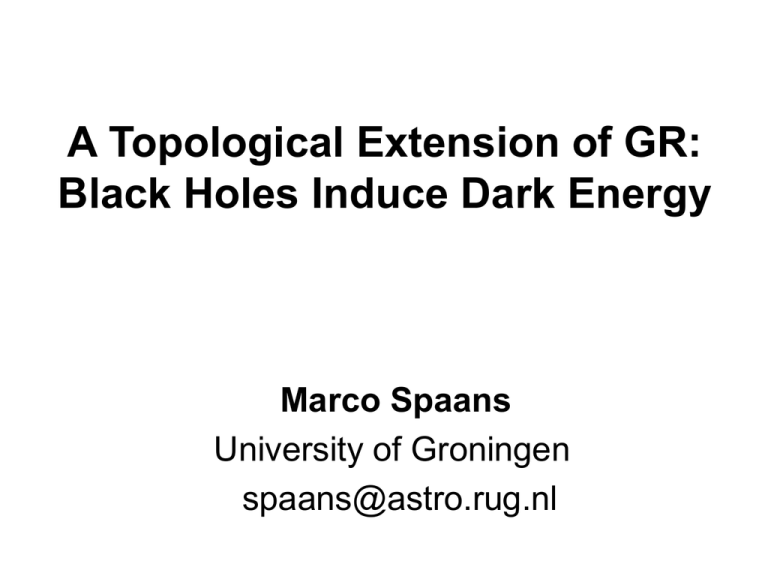Topology in Gravity
advertisement

A Topological Extension of GR: Black Holes Induce Dark Energy Marco Spaans University of Groningen spaans@astro.rug.nl General Relativity • Equivalence principle: Einstein’s local interpretation of Mach’s global principle. • GR not invariant under local conformal transformations → singular metric fluctuations on the Planck scale: Wheeler’s (1957) quantum foam of wormholes. • GR elegant and succesful, preserve in quantum gravity. • The Einstein equation Gμν = 8πGN Tμν does not specify local and global topology. The Equivalence Principle: Macro- versus Microscopic paths Need to specify what path to take quantummechanically. Put Differently: The Feynman (1948) Path Integral • A particle/wave travels along many paths as an expression of the superposition principle: connect any A to any B. . • ∫ paths eiS leads to a semi-classical world line and a large scale limit for GR. But, how to distinguish paths on LPlanck? Observers cannot tell paths apart locally due to errors! • This talk: Choose paths that can be identified despite quantum uncertainty in geometry; paths fundamental and rooted in topology; Spaans 1997, Nuc.Phys.B 492, 526. ↔ Space-time on the Planck scale (10-33 cm) is a fabric woven of many paths: shape → connectivity. Physics: Multiplicity • Scrutinize down to Planck scale: strong coupling between observer and observee. • To identify a path, which is distinct under continuous deformation of space-time, one needs a proper example to compare to. • Thought: It takes one to know one. So topological fluctuations on LPlanck take the form of multiple copies of any path through quantum space-time (i.e., in 4D). • Idea: Topological dynamics on LPlanck because no distinct path can (remain to) exist individually under the observational act of counting, thus building up quantum space-time. Mathematics: Loop Algebra • Use 3D prime manifolds P: T3, S1xS2, S3 to construct a topological manifold, with the S1 loop as central object: Two distinct paths from A to B together form a loop. • T3, three-torus (Χ=0→LM), provides topologically distinct paths through space-time. Superposition by Feynman. • S1xS2, handle (LM), can accrete mass as well as Hawking (1975) evaporate (so BH~wormhole in 4-space). The handle represents Wheeler’s quantum foam. • S3, unit element (simply connected, large scale limit). • Minimal set. Physical principle: find the paths that thread Planckian space-time (Feynman+Wheeler). Mathematical principle: topological constructability (primes+homeomorphisms); Spaans 2013, J.Phys 410, 012149 Constructing Space-Time Topology Define Operators T (annihilation) and T* (creation): • TP ≡ nQ, n=number of S1 loops and Q is P with an S1 contracted to a point (dimension-1). • T*P ≡ PxS1 (dimension+1). • [T,T*] = 1 (non-commuting). • NS3 = S3, NT3 = 7T3, NS1xS2 = 3S1xS2. • N≡T*T+TT* (symmetric under T ↔ T*): counting. • Repeated operations with N allow one to build a spacetime with Planck scale heptaplets of three-tori and Planck mass triplets of handles embedded in 4-space. Equation of Motion: Counting = Changing • n[T3](m) = 7m for discrete m=0,1,2,…; topological time t=(m+1)TPlanck and a continuous interval (m+) ≡ (m,m+1). • n[S1xS2](m+1) = 3n[S1xS2](m) +Form(m+) -Evap(m+) -Merg(m+) → n[S1xS2](m) = 3m if F,E,M small (drives inflation), 2n[S1xS2](m) = Evap(m+) if F,M and δn[S1xS2] small; for every Planckian volume, independent of BH location. • Matter degrees of freedom F,E,M modify the number of handles: GR part of quantum space-time through longevity and transience of all BHs. Multiply Connected Space-Time • Topologically distinct paths, under homeomorphisms, between any two points: • Use T3, S1xS2 and S3 • Build a lattice of three-tori, with spacing LPlanck, to travel through 4D space-time as an expression of the superposition principle and attach Wheeler’s handles: Quantum paths that connect points are then globally identified through non-contractible loops. ▄ Topological Induction of BHs • Solution 2θ(m) = Evap(m+), for the number θ of BHs in a time slice of width ~TPlanck: Space-time responds globally to local BHs by inducing Planckian BHs. Wave function of the universe collapses when BH forms. • Planckian BHs evaporate in about Tev~TPlanck. • Macroscopic BHs θ living longer than a Hubble time generate a globally stable quantum foam density Λ. • Extension of Einstein gravity and Mach’s principle: Global topology and geometry determine (changes in) Planck scale topology and the motions of matter, and vice versa. • Λ = θ mPlanck / Lf3, with Lf the size of the universe when the first long-lived BH, so with Tev[m']>Tuniv[m], forms: Lf is frozen in when one has a global 4-space topology in the sense of Mach and the quantum foam stabilizes. Dark Energy • Cosmological observations suggest an accelerated expansion of the universe, usually attributed to some form of vacuum energy Λ: Einstein’s cosmological constant in the form of dark energy (Riess ea 98, Perlmutter ea 98, etc.), with ρ0~10-29 g cm-3. This while θ~1019 today. • Topological induction then requires the dark energy to follow the number of macroscopic BHs in the universe. Induced Planckian BHs require an increase in 4-volume for their embedding: Lf≈2x1014 cm from ρ0 and θ. • Observed star/BH formation history of universe yields: Λ(z)/Λ(0)~(1+z)-0.36, z<1; a ~30% decline: w ≈ -1.1, not constant, consistent with observations (Aykutalp & Spaans 12). In fact, w = -1.13 ± 10% (Hinshaw ea 12; Planck: Ade ea 13). Summary • Use the topological freedom in GR to implement the superposition principle through the notion of globally distinct paths for particles to travel along. • The S1 loop dynamics of three-tori and handles generate such paths: multiply to identify. Leads to the creation of Wheeler’s Planckian BHs by macroscopic BHs, i.e., a testable form of dark energy. • What if (many) primordial BHs evaporate until today? • Inflation driven by induced mini BHs: n≥55 e-foldings, n~ln(Lf/LPlanck)1/2 ~lnθ1/6. • Further scrutiny of the lattice of three-tori is necessary: fluctuations with ns=1-r ≈ ln(7)/n = 0.96 and macroscopic temporal displacement in the CMB with amplitude 1/14.







